Key takeaways:
- Consistency in messaging and branding builds trust and loyalty among audiences, enhancing brand recognition and consumer preference.
- Defining clear short-term and long-term campaign objectives allows for focused execution and effective measurement of success.
- Utilizing campaign management tools streamlines organization, enhances collaboration, and improves responsiveness to real-time analytics.
- Regularly monitoring campaign performance and adapting strategies based on insights lead to more effective and resonant marketing initiatives.
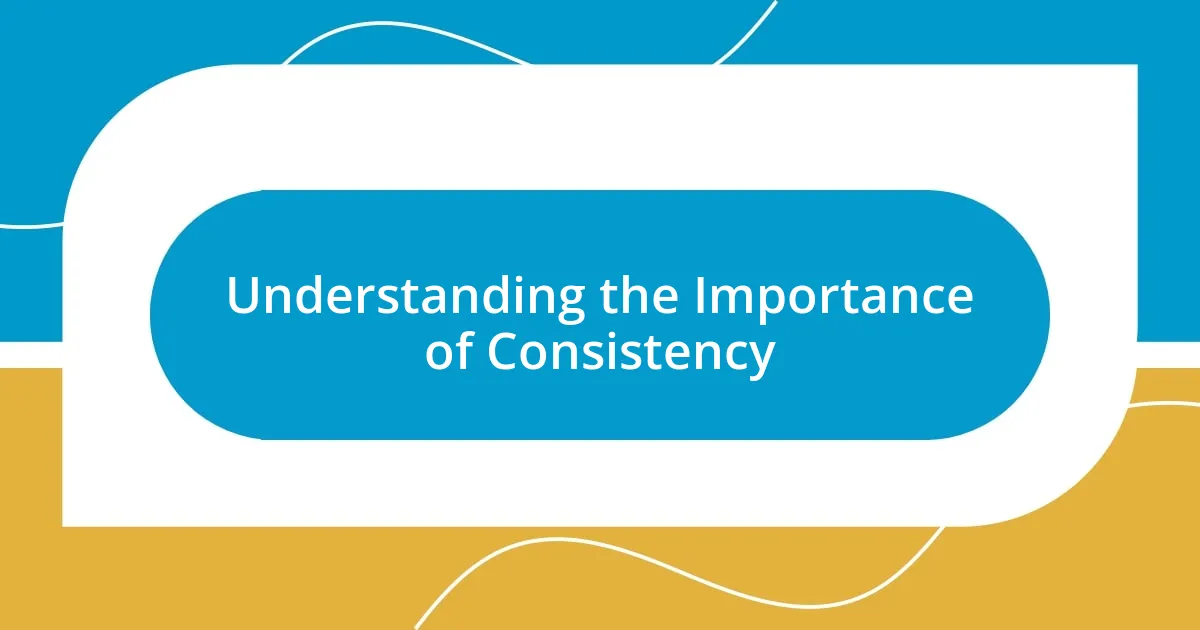
Understanding the Importance of Consistency
Consistency isn’t just a buzzword; it’s the lifeblood of any successful campaign. I remember a time when I launched a marketing initiative without a clear, consistent message. The results were baffling, and honestly, a bit disheartening. It taught me that without a uniform voice and visual identity, your audience can become confused and disengaged. Doesn’t it make you think about how often we encounter brands that struggle to communicate effectively?
What really strikes me is how consistency builds trust. I always emphasize to my team that when our messaging and branding remain steady, it fosters credibility. Think about it: have you ever followed a brand that seemed to change its tone or direction frequently? It can be jarring, right? When audiences know what to expect, they’re more likely to remain loyal, and in my experience, loyalty often translates into more sales and long-lasting relationships.
Moreover, consistency supports brand recognition. I’ve had moments when I’ve effortlessly recognized a company just by their color scheme or tagline. This instant recognition creates a familiarity that can lead to consumer preference over competitors. I can’t help but wonder—how many opportunities have been lost by brands that fail to create a cohesive identity? The emotional connection you build through consistency can ultimately make all the difference in how your campaign performs.
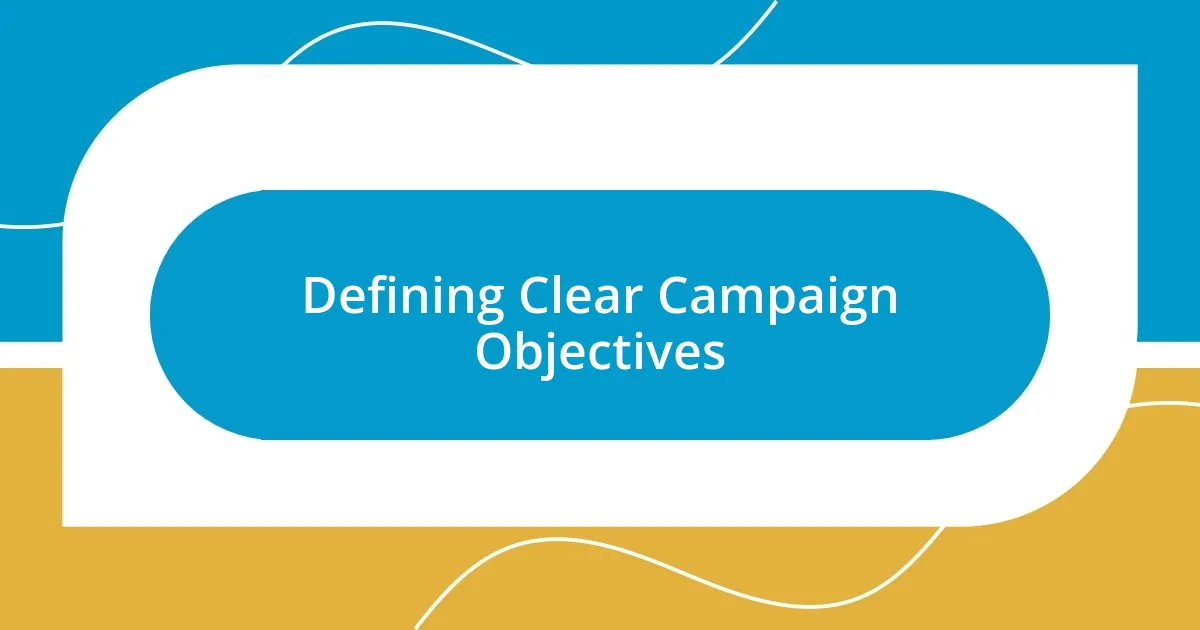
Defining Clear Campaign Objectives
Defining clear campaign objectives is the bedrock of effective marketing. I often find myself reflecting on past campaigns where ambiguity muddled our approach. For instance, in one project, we aimed to increase brand awareness, but without defining specific metrics, we struggled to gauge success. Establishing objectives like “achieve a 20% increase in social media engagement” can empower a team to focus and measure results effectively.
When I set objectives, I distinguish between short-term goals and long-term aspirations. I recall when I organized a product launch; my short-term objective was to secure 500 pre-orders in the first month, while the long-term goal was to establish a loyal customer base. This duality helps me prioritize tasks and assess whether our strategies are aligning as intended. What’s your experience with navigating between immediate needs and overarching visions?
I’ve learned that involving team members in formulating these objectives also fosters ownership. In one campaign, I held brainstorming sessions, which not only sparked creativity but also ensured everyone felt invested in the outcome. This collaborative effort often uncovers insights that lead to more precise and impactful objectives, eventually reflecting in the campaign’s success.
| Objective Type | Description |
|---|---|
| Short-Term Goals | Tangible, immediate targets linked to specific campaigns, such as sales numbers or social media metrics. |
| Long-Term Goals | Broader aspirations that align with the brand’s vision, like customer loyalty and market position. |
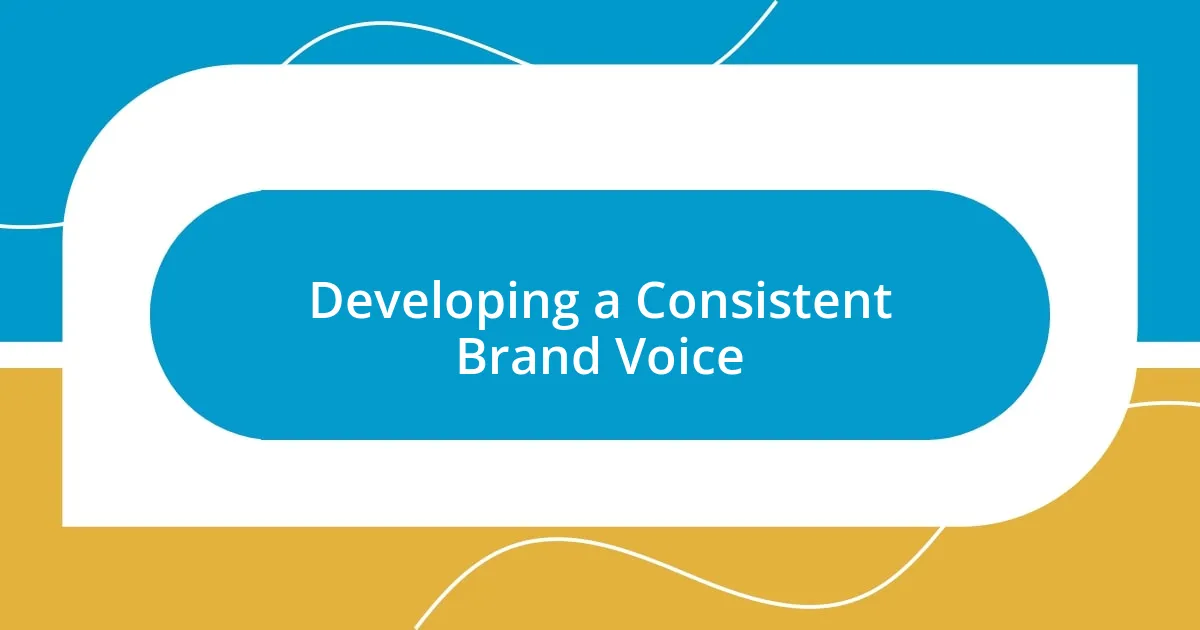
Developing a Consistent Brand Voice
Developing a consistent brand voice is a crucial element of effective storytelling that resonates with your audience. In one campaign where I focused on a more playful tone, I noticed a significant uptick in engagement. It wasn’t just a shift in language; it was about genuinely reflecting our brand’s personality. When consumers hear your voice consistently across various platforms, they start to form a relationship built on familiarity and trust. Have you ever felt the warmth of a brand simply by how they communicate? That’s the power of a well-defined tone.
To maintain that voice across campaigns, here are key strategies I’ve found effective:
- Define Your Core Values: Understand what your brand stands for and let those values guide your tone.
- Create a Style Guide: This blueprint helps ensure everyone knows how to convey the brand voice, from social media posts to internal communications.
- Train Your Team: Regular workshops or training sessions can help your team internalize the brand voice.
- Monitor Feedback: Pay attention to how audiences respond and be willing to tweak your approach while staying true to your core voice.
I know it can be challenging to strike that balance, but when you do, you create a consistent experience that helps customers feel truly understood.

Utilizing a Campaign Management Tool
Utilizing a campaign management tool has transformed the way I approach marketing. I remember when I once juggled multiple campaigns manually; it was overwhelming and chaotic. Now, with tools like Asana or Trello, I can visualize tasks, deadlines, and responsibilities at a glance, which brings structure and clarity to my campaigns. Don’t you find it refreshing to have everything organized in one place?
These tools offer functionalities that go beyond mere task management. For instance, I use the analytics features to monitor campaign performance in real-time. The ability to adjust strategies on the fly based on data insights has improved both efficiency and outcomes. Have you ever noticed how small changes, guided by real-time analytics, can make a significant difference?
Collaboration has also flourished since I started using these tools. Team members can easily comment on specific tasks, share files, and update progress. I recall, during a particularly intense campaign, how this real-time communication helped us quickly resolve misunderstandings and align creative visions. It truly fosters a sense of teamwork and can elevate a campaign from good to great. How do you facilitate collaboration in your projects?
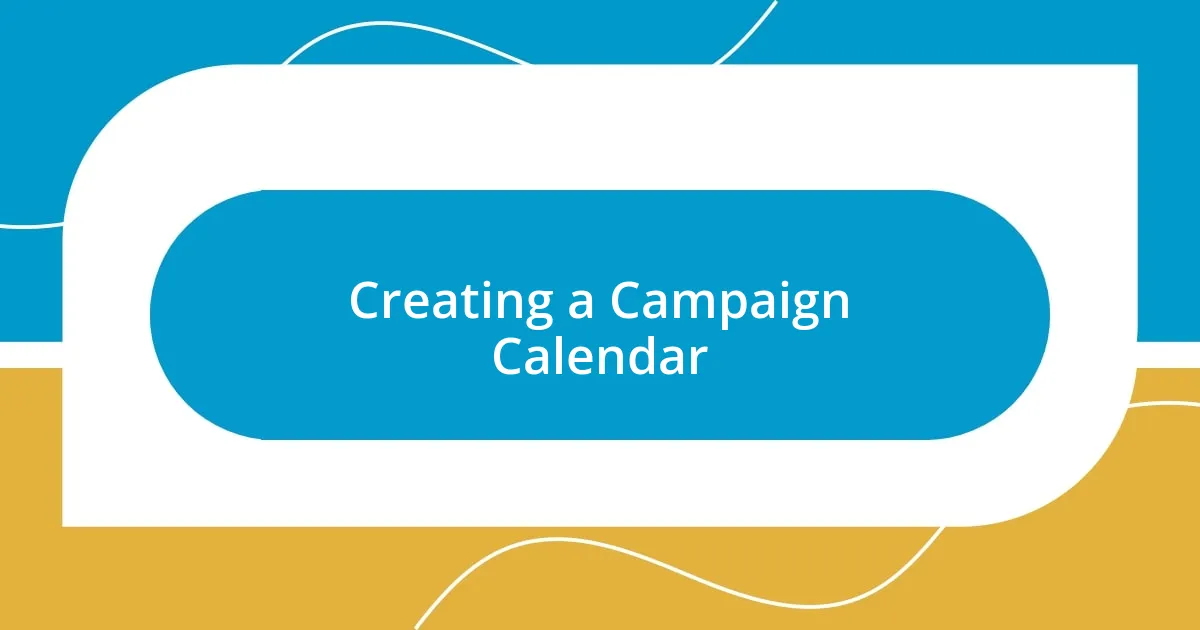
Creating a Campaign Calendar
Creating a campaign calendar has been a game-changer in my marketing efforts. I remember when I used to plan campaigns haphazardly; I often lost track of deadlines and key activities. Developing a structured calendar allows me to visualize all my campaigns and their timelines at a glance. It’s like having a roadmap that guides me through the chaotic world of marketing. Have you ever felt the sense of relief that comes from having a clear path laid out?
To build my calendar, I start by marking significant dates, like product launches or holidays. This groundwork sets the tone for what I can emphasize in each campaign. For instance, during Valentine’s Day last year, I aligned my messaging with themes of love and connection, tapping into the emotional aspect that resonates with my audience. This alignment not only made the campaigns more effective but also created a cohesive story that unfolded throughout the month. How do you identify and integrate those key moments into your planning?
Flexibility is essential, too. I once planned an elaborate campaign around a seasonal event, only to find that customer interests shifted unexpectedly. Being adaptable meant I could pivot and update my calendar without scrambling at the last minute. I dig deeper into metrics and feedback, which guide me in reshaping my approach. Do you find that staying flexible helps you seize new opportunities that arise?

Regularly Monitoring Campaign Performance
Monitoring campaign performance is a crucial element that I take very seriously. I’ve learned that checking in on performance metrics is not just a formality; it’s a chance to stay connected with my audience and their behaviors. For example, I remember a campaign where I noticed engagement drops after a few days. Prompt adjustments, like tweaking the content or targeting, revitalized the campaign. Isn’t it fascinating how simply being attuned to the data can lead to significant improvement?
I find that setting specific intervals for performance reviews keeps me accountable. In my experience, weekly check-ins reveal patterns that can easily go unnoticed if left for a monthly review. One particular instance stands out: I nearly missed a growing interest in a previously overlooked demographic because I wasn’t reviewing data frequently enough. Regular monitoring transformed that missed opportunity into a tailored campaign that resonated well. What insights have you gained from your own continuous assessment?
A key takeaway from my journey is that it’s not just about gathering data; it’s about telling a story with it. I recall a campaign where the numbers told one thing, but I felt something different looking at audience feedback. Trusting those feelings allowed me to pivot creatively and connect with my audience on a deeper level. How do you blend numbers and intuition in your decision-making process? By regularly monitoring performance and listening to both data and emotional cues, I’m able to maintain a dynamic and effective campaign strategy.
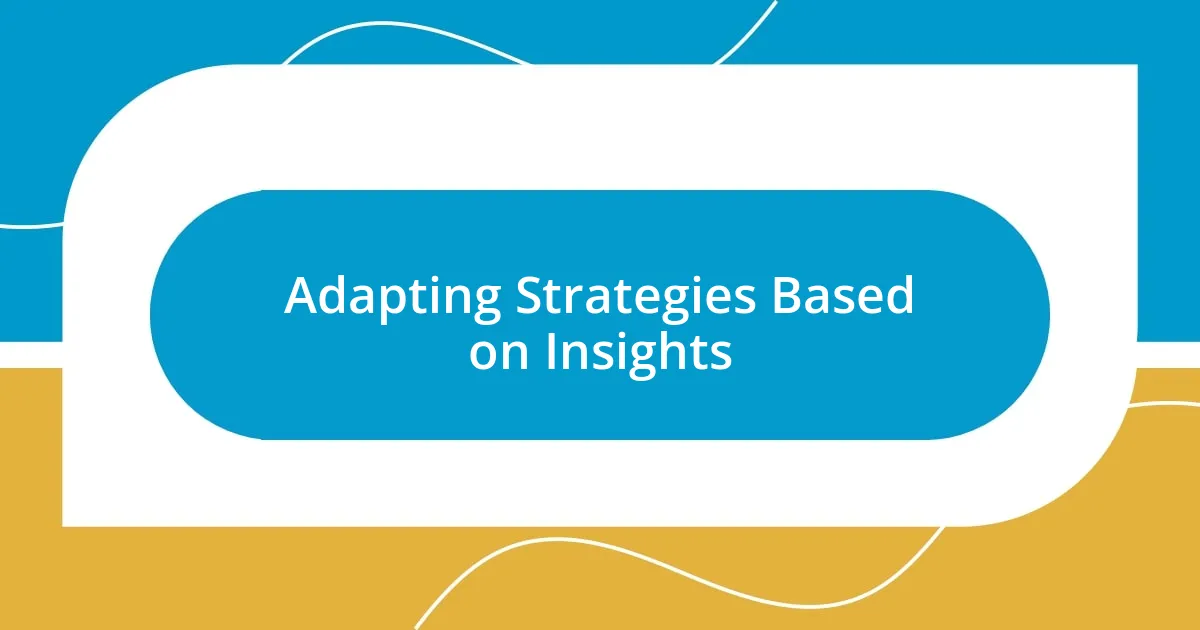
Adapting Strategies Based on Insights
When it comes to adapting strategies based on insights, I’ve found that diving deep into analytics can reveal surprising revelations. I remember a time when a campaign was underperforming, and I took a closer look at the audience feedback. Surprisingly, I discovered that the messaging didn’t resonate, as people were seeking authenticity rather than just promotional content. It really hit home for me—how often have you misread your audience’s needs?
Adjusting my approach based on these insights can be a powerful move. For instance, during a product launch, I noticed a spike in engagement on social media when I shifted the message from product features to storytelling. This change not only boosted shares but created a genuine connection with the audience. Who wouldn’t want to communicate in a way that feels more relatable and less transactional?
Ultimately, adaptation requires a willingness to stay curious and open-minded. I recall a campaign where I initially planned an aggressive discount strategy. After analyzing the insights, I pivoted toward highlighting the product’s value instead. The result was better customer satisfaction and loyalty. Have you ever reconsidered your strategy based on insights, and how did it impact your campaign outcome? By prioritizing what I learn from data and emotions, I find that my campaigns become not only more effective but also more enjoyable to create.














